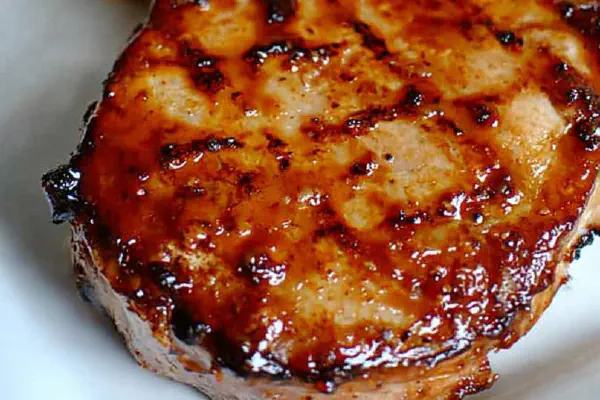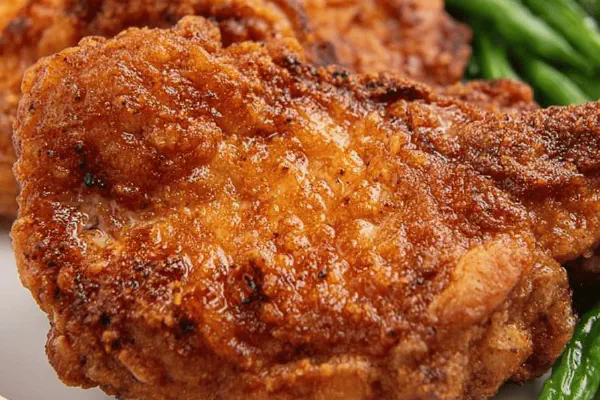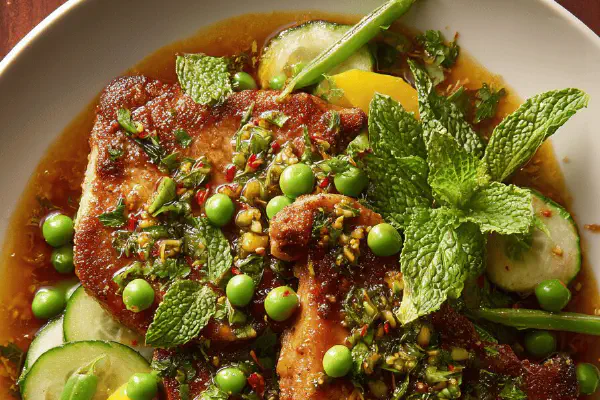Featured Recipe
Korean Glazed Pork Shoulder

By Kate
"
A Korean-inspired slow-cooked pork shoulder with a tangy, caramelized crust and spicy dipping sauce. The pork is dry-brined then cooked low and slow until tender, finished under high heat for a sticky glaze. Served with fresh lettuce, crisp cucumbers, sesame seeds, and kimchi. A balanced contrast of textures and bold flavors. Uses ssamjang and gochujang for heat and umami. Substitutes apple cider vinegar with rice vinegar for a sharper bite. Brown sugar swapped for honey adds a floral note. Ideal for hands-on plating with vibrant garnishes.
"
Prep:
40 min
Cook:
Total:
Serves:
8 servings
Korean
pork
slow cooking
dinner
Introduction
Slow cooking pork shoulder low and slow breaks down connective tissue, transforms toughness to tender mouthfuls. Here, a dry-brine with sugar and salt draws moisture out, concentrates flavors. Honey swaps add complexity, caramelizes better at high heat. Caramelizing at end? Not just for color. Builds quick crust loaded with sweet-savory notes. The ssamjang-gochujang combo brings sharp, fermented funk and bright heat—key Korean flavors familiar from Korean BBQ night. Serve with crisp lettuce leaves and kimchi—important to cut fat, refresh palate. Each bite balanced—sweet, tangy, spicy, crisp, fatty. No fluff, no fuss—just methodical timing and sharp sensory cues. Touch and smell tell when to move next. Overcooking risks dryness; too little, chewy. Nail transitions between low roasting and scorching glaze. No shortcuts if you want proper crust and moist pull-apart meat. Expect some skill in handling layers of texture while flipping from slow to sear. Watch juices, aromas, textures—then serve family style, interactive and casual.
Ingredients
Korean Sauce
- 60 ml ssamjang (fermented soybean chili paste)
- 20 ml gochujang (fermented chili paste)
- 25 ml toasted sesame oil
- 15 ml fresh grated ginger
- 5 ml rice vinegar (1 tsp)
- 2 green onions chopped
- 1 garlic clove minced
- 2 heads curly lettuce leaves separated
- 2 Lebanese cucumbers thinly sliced
- Steamed sushi rice warm
- Toasted sesame seeds
- Store-bought or homemade kimchi
Garnish
About the ingredients
Use pork shoulder over loin—more fat, connective tissue needed for melt-in-mouth finish. Trimming rind makes roasting even. Salt and sugar create a mild cure through dry-brining; essential for moisture retention and flavor punch. Honey replaces brown sugar, gives more complex caramel scent under high heat. Vinegar choice affects tang—rice vinegar sharper, cider softer. Ssamjang and gochujang foundational Korean ferments; if missing, miso paste with hot chili flakes okay stand-ins. Sesame oil toasted for nuttiness, ginger and garlic brighten sauce. Fresh green onion gives crunch and aroma contrast. Lettuce and cucumber provide textural sharpness; kimchi acidity balances richness. Steamed sushi rice binds in wrap; sticky texture holds meat, sauce. Sesame seeds toast briefly until dark spots appear and smell nutty—not burnt. Store them in airtight container to keep fresh—burnt seeds bitter.
Method
Technique Tips
Dry-brining pork uncovered lets surface dry slightly, essential for proper caramelization later. Massage ensures even absorption. Slow roast covered retains moisture but drying out can make crust. Remove foil last hour to develop crust, baste with pan juices to keep moist. Visual cues—pork shrinking, fibers loosening when poked—tell tenderness better than clock. High heat glaze step intensifies flavor and texture contrast. Brush glaze evenly; avoid drizzling or pooling to prevent burning. Resting loosens fibers, juices redistribute. Use two forks for shredding to avoid mush. Sauce whisking requires fine mincing for ginger and garlic to avoid harsh bites. Adjust heat balance to preference; sauce can be prepped ahead and refrigerated. Presenting stuff-yourself style encourages interactive eating, no one messes up a wrap. Leftovers benefit from reheat with splash of broth before assembling wraps. Schedule your time so slathering glaze overlaps with sauce prep.
Chef's Notes
- 💡 Always start with a dry brine. Salt, sugar mix, rub it in, let rest. Pork needs time; 30-45 minutes should suffice. Draw moisture out.
- 💡 Oven control is key. If cooking appears tough, lower temp. 130°C, extend an extra 30 minutes. Should become tender from slow heat.
- 💡 Glaze timing is everything. Last part, watch closely. 7-9 minutes max or edges burn. Brush glaze on, avoid pooling. Better caramelization.
- 💡 Sauce can prep ahead. Keeps warm on low. Ssamjang, gochujang add umami. Adjust spices based on heat preference. Bold flavor, not overpowering.
- 💡 Resting meat after cooking is essential. Juices redistribute, fibers loosen. Shred with two forks for best texture. Avoid mushy results.
Kitchen Wisdom
What if pork is tough?
Chewiness indicates too low cooking temp. Consider returning to oven, wrap tightly. Done when fibers break apart.
How to store leftovers?
Different methods work. Freeze shredded pork in bags. Refrigerate for short term. Reheat with broth, prevents dryness.
What to do if glaze burns?
Adjust oven rack. Keep an eye on last minutes of cooking, check for caramelization. Quickly reduce heat if needed.
Can I substitute ssamjang?
Yes, use equal parts miso blend with chili paste. Tastes vary so always adjust to personal preference, less heat if needed.



